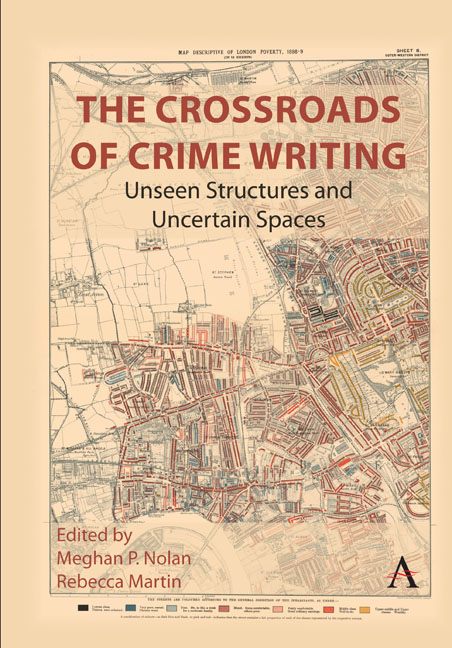Book contents
- Frontmatter
- Contents
- Introduction
- Unseen Structures
- Chapter 1 Unseen Structures and the Outlaw: Depictions of Violations in Stieg Larsson’s Millennium Trilogy
- Chapter 2 Dark Waters: Eco-Noir in New York 2140
- Chapter 3 Between Lenin and Sherlock Holmes: Soviet Militsiya Procedural in Volodymyr Kashin’s Detective Fiction
- Chapter 4 Detecting Justice: Black Crime Fiction and the Novels of Attica Locke
- Chapter 5 The Police and the Private Eye: The Making of Gendered and Racial Peripheralization in the Crime Fiction of Valerie Wilson Wesley
- Uncertain Spaces
- Chapter 6 Navigating the Carceral City: Calcutta in Late Nineteenth-Century Narratives of Detection
- Chapter 7 Traversing the Borders of Poverty and Morality: The Intersection of Maps and Upper-Class Ethics in Anne Perry’s Neo-Victorian Series
- Chapter 8 Facts and Fictions: The Liminal Space Between True Crime and Crime Fiction
- Chapter 9 The Success(Ion) and Corruption of Crime Genres in Jo Nesbø’s Macbeth (2018)
- Chapter 10 The Golden Age Meets the Age of Aquarius: Agatha Christie in the 1960s
- Notes on Editors and Contributors
- Permissions
- Index
Chapter 3 - Between Lenin and Sherlock Holmes: Soviet Militsiya Procedural in Volodymyr Kashin’s Detective Fiction
Published online by Cambridge University Press: 13 April 2024
- Frontmatter
- Contents
- Introduction
- Unseen Structures
- Chapter 1 Unseen Structures and the Outlaw: Depictions of Violations in Stieg Larsson’s Millennium Trilogy
- Chapter 2 Dark Waters: Eco-Noir in New York 2140
- Chapter 3 Between Lenin and Sherlock Holmes: Soviet Militsiya Procedural in Volodymyr Kashin’s Detective Fiction
- Chapter 4 Detecting Justice: Black Crime Fiction and the Novels of Attica Locke
- Chapter 5 The Police and the Private Eye: The Making of Gendered and Racial Peripheralization in the Crime Fiction of Valerie Wilson Wesley
- Uncertain Spaces
- Chapter 6 Navigating the Carceral City: Calcutta in Late Nineteenth-Century Narratives of Detection
- Chapter 7 Traversing the Borders of Poverty and Morality: The Intersection of Maps and Upper-Class Ethics in Anne Perry’s Neo-Victorian Series
- Chapter 8 Facts and Fictions: The Liminal Space Between True Crime and Crime Fiction
- Chapter 9 The Success(Ion) and Corruption of Crime Genres in Jo Nesbø’s Macbeth (2018)
- Chapter 10 The Golden Age Meets the Age of Aquarius: Agatha Christie in the 1960s
- Notes on Editors and Contributors
- Permissions
- Index
Summary
Detective Fiction from Stalin to Brezhnev
In the Stalinist era in the USSR, detective fiction was actually a taboo genre. It was distinctly associated with so-called bourgeois, hostile values and was seen as a means of corrupting the petty-bourgeois strata of society. The figure of the public security officer in the literature was overshadowed with the figure of a brave Chekist (a Soviet political security officer), who waged a ruthless struggle against class enemies and other antagonistic elements, both external and internal. Instead of a policeman, there was a spy or counterintelligence officer in the arena. It is clear that such texts were propagandistic rather than literary. It was only after the death of Stalin and the fall of the regime of Lavrentiy Beria, in the mid-1950s, that the question of creating a new image of law enforcement arose. During the Khrushchev Thaw, the Soviet govern-ment tried to make this image more humane, closer to the citizens, to bridge the gap between the state and society: the police (militsiya) protects ordinary workers and peasants and does not persecute and punish them. Therefore, the authorities welcomed the first attempts to present a new hero in literature: a police officer.
It was at that time, in the 1960s, that the rise of the militsiya detective novel, the genre that became an analogue of the Western police procedural in the Soviet Union, took place. This genre, rich in documentary elements and close to an essay, was a variant of an occupational (labor-related) novel. At the same time, the Soviet militsiya novel reveals typological similarities with the Western police procedural: both depict a collective hero and, instead of a brilliant lone detective, there is an ordinary employee, part of the law enforcement system. The first book of this genre was Ivan Lazutin's novel Militsiya Sergeant (1959). Later works by Arkady Adamov, Nikolay Leonov, and Julian Semenov formed a genre pattern of the militsiya procedural story. As early as in the 1970s, such stories widely circulated and acquired their plot stereotypes, so against their background stood out the most striking examples of the genre: the novels of Arkady and Georgiy Vayner A Vertical Race (1971), A Visit to the Minotaur (1972), A Cure for Fear (1978), and The Era of Mercy (1976).
- Type
- Chapter
- Information
- The Crossroads of Crime WritingUnseen Structures and Uncertain Spaces, pp. 63 - 80Publisher: Anthem PressPrint publication year: 2024

